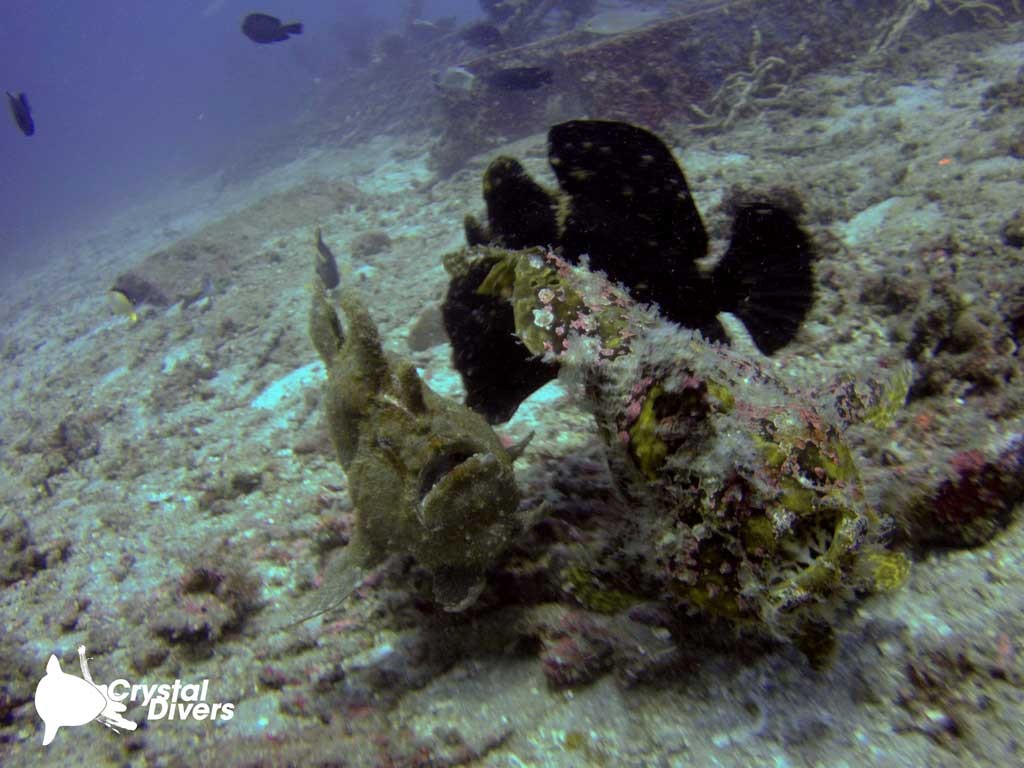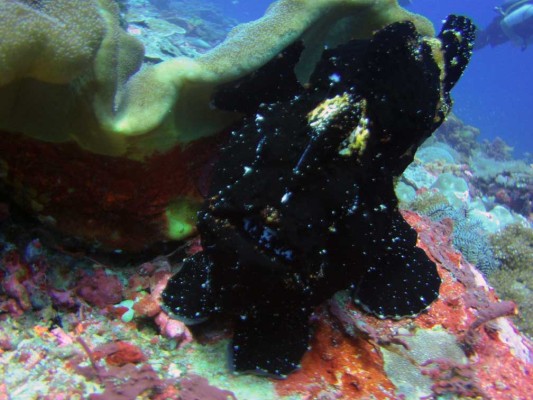We were lucky to witness frogfish mating in Bali
Frogfish are masters of disguise. Spot one during a dive and you will win the admiration of every diver in your group but especially the photographers, if you spot 3 of them swimming and mating you will be praised.
Frogfish is a type of Anglerfish the master of disguise. While they do not have scales, their amazing ability to camouflage themselves serves as protection from predators and also helps them hunt. Frogfish vary in color and often have unique spines or bumps that change with their surroundings.
We were lucky to spot 3 of them, 1 big female being chased by 2 smaller males mating. So I thought I would give you a short rundown on how they do it, some facts about frogfish reproduction.
But first enjoy this video we made:
The reproductive behavior of a frogfish is still not fully researched and understood but this is what is known. There are few observations in aquariums but even fewer from the ocean. Most frogfish species are free spawning, where the females laying the eggs in the open water and males coming in behind the female to fertilize them once they are released in the water. The whole mating procedure can take anywhere from eight hours to several days before the eggs are released and fertilized. The “stomach” of the female starts to swell as the eggs absorb water, they can have up to 180,000 eggs. The male begins to approach the female around two days before the spawning. It is not known if the spawn is influenced by some external factor, such as the phase of the moon, or if the male is attracted to a smell or signal released by the female. In all observed breeding pairs, one partner was noticeably, sometimes as much as ten times, larger than the other. When the gender could be determined, the larger partner was always the female. As you can see the middle one in this movie that we were lucky to film on a dive in Padang Bai last week.

During the free spawning ritual, the male swims besides and slightly behind the female and nudges the female with his mouth.
Just before the spawning, the female begins to swim above the ocean floor toward the surface. This proceeds at a rapid rate so that shortly before spawning the females stomach is so swollen (full of eggs), it is hard for her to maintain her position on the bottom. She becomes buoyant (tail up as you can see in the video) and is followed around closely by the male. The male continues to nudge the female in the “stomach”, and they move quickly to the surface, where spawning happens. So At the highest point of their swim they release the eggs and sperm before descending back. Sometimes the male pulls the eggs out of the female with his mouth. After mating the partners depart quickly as otherwise the smaller male would could risk being eaten by the female in the cases where the female is much larger than the male. The frogfish may spawn several times over a few weeks so it’s not just a one time spawn several occasions over the next few weeks.
Parenting ends with mating. The thousands of eggs are released encapsulated in a ribbon-like buoyant mass of mucus known as an epipelagic egg raft, that drifts for several days crossing large distances and then sinks to the bottom after the embryos hatch. The plank tonic stage lasts probably 1 to 2 months. Even small larvae of 5 to 10mm have a lure so they can start hunt straight away.
A few frogfish species show special parental care for their eggs. The female attaches a cluster of eggs with a threadlike structure to the surface of his body and carries them around until they hatch. One of the mating pair stays close to guard their eggs. Would-be predators lured into the range by the embryos are known to be eaten by the parent frogfish! Females lay about 5000 eggs in a large mass. The egg mass consists of numerous single-egg strings attached to a gel “ball/disc”. As the male releases sperm, the female fans the eggs with the caudal fin, trying to spread them out. During this process the male is expelled. Sticky threads entangle themselves with the surrounding growth on rocks. The female then covers the eggs completely with her side and guards them. The young hatch after about 30 days and settle in crevices at the bottom.
If you never seen a frogfish then Bali is a great destination to see them so get in touch with us and we will do what we can for you to be able to spot these amazing creatures. There are several sites where you will have big chances of seeing various types of frogfishes.
One of my personal favorites is Padang Bai Jetty where you most likely will see more than one. This is also a site where you will see multiple types of pipefish and you might be lucky to spot a wonderpus and other octopuses.
Other dive sites that Crystal Divers go to to see frogfishes is Seraya, Amed, if your eye is very sharp you might be lucky to see them on the USAT liberty wreck in Tulamben to !
So what are you waiting for book your dive and lets go and find them !!




